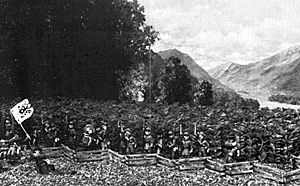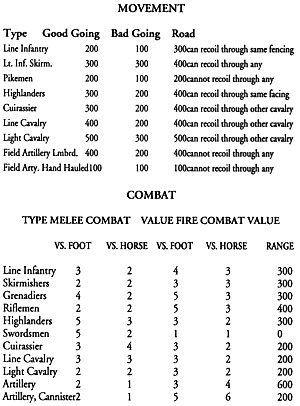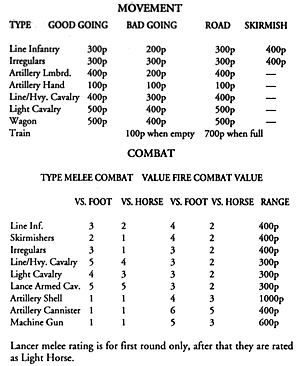 DBA for tbe ACW? Figures are Frontier and Old Glory from the collection of the photographer. Photo by Orv Banasik
DBA for tbe ACW? Figures are Frontier and Old Glory from the collection of the photographer. Photo by Orv Banasik
Well. you've seen everything now, Nick Nascati writing an article on a mainstream set of rules, used by a majority of gamers, and presenting variants that extend the rules to cover other mainstream periods!
The appearance of these rules has been single-handedly responsible for my painting up huge numbers of 20mm plastic Ancient/Dark Ages figures over the past year. I must admit that games, while decidedly abstract, are quite a lot of fun. However gamers will be gamers, and I decided to have a go at putting the system to use for other periods.
While WRG is apparently planning to release a version to cover later periods, there has been no definite word about when this will occur. So, I sat down with some research materials, and put together two variants for periods in which I am interested.
The beauty of the DBA system, as others have made mention, is the relatively small number of figures needed for the armies. The result of this is that gamers are able to experiment with specific incidents that they might otherwise have never even considered. The genesis of the two variants that follow, will provide an excellent example of just that.
So, with only slight apology to Phil Barker, I present the rules which follow.
 1. DBA EARLY HORSE AND MUSKET VARIANT
1. DBA EARLY HORSE AND MUSKET VARIANT
One of my favorite periods has always been the transitional period around the turn of the 18th century, the age of Marlborough and Louis XIV. Massive squadrons of cavalry charging boot to boot, and steady battalions of infantry, quite a spectacle. With a couple of fine 15mm ranges out covering this period, it seemed an ideal one to use with the DBA system.
Along with this era, I've lately developed a fascination with the 1745 Jacobite Rebellion, so a set of rules covering the whole period up to the end of the Seven Years War, seemed to be the way to go. After several test games, I settled on the changes you see presented now. I found it better to provide separate melee and fire tables, as that seemed to give better results, since the majority of figures would be carrying firearms in this period.
All troops who are beaten by a score 2x their score or more are destroyed, except light infantry, who will retreat 600p. Note that lights, when charged, may evade I base depth.
Fire at targets in open order, i.e., skirmisher or artillerymen, will result in a deduction of -I to the fire's value.
Highlanders charging will lose the ability to engage in missile combat for the rest of the game, following historical tactics.
Artillery firing shot WILL NOT destroy any stands capable of being pushed back; instead, when the score indicates a kill, the target will be pushed back 300p.
All troops, including lights, are destroyed on any roll when fighting in bad terrain.
Artillery bases are destroyed by any melee loss.
Artillery movement. While limbered, guns may move as much as they wish. Once they have been deployed, however, they may only be hand hauled to change direction, or must spend a turn to limber up.
For each pike base backed up by a second rank of pikes, add +3.
For each attack on the flank or rear, deduct -1.
Troops contacted while uphill, add + 1.
NOTE TO TURN SEQUENCE, THE PLAYER HAVING THE INITIATIVE FIRES AFTER THE PLAYER WHO IS ON THE DEFENSIVE.
 II. DBA MID- 19TH CENTURY VARIANT
II. DBA MID- 19TH CENTURY VARIANT
I've always been intrigued with the various wars of the mid19th century, from the Crimea to the various struggles between France, Germany, Austria, and Italy. A birthday gift finished the job just recently. The gift was a book of models by Italian collectors, with a heavy concentration on the uniforms worn during the Wars of Unification. Perusing catalogs of 15mm figures, I was satisfied that figures to duplicate these armies were available, so yet another DBA variant was born. In this case though, I lean towards looking at the bases as companies rather than battalions. This is only a personal opinion, though, and the rules have in no way been altered to reflect a lower level organization.
All infantry in this period may skirmish, extended order being represented by having one base width between figures. Thus, the bases move faster, but cost a point each.
Taking into account improvements in command control, there will be a new restriction as to the distance bases may be from the general, that being 2400 paces.
Artillery may move as often as desired as long as it remains limbered; once it has been deployed, it may only be hand hauled to adjust firing angle, or cost a point to limber up.
Note that in this period, Bad Going will be extended to include: railroad tracks, trenches, and any other terrain obstacles not found in the earlier periods.
The general's base will only count for command control purposes, and is not included in the 12 bases or in victory conditions. Note that it may be desirable to increase the size of the armies for this period, as long as both field the same number of bases. Victory conditions will remain the same, i.e., when one side loses 1/3 of its strength.
Given the ability to skirmish, all troops may recoil through others in the same facing, with the exception of artillery. However, they will be assumed to do so in extended order.
All troops except Light Horse and Irregulars are destroyed when the opponent's die score is 2x theirs or more. The latter are pushed back 600p, they are only destroyed if there is no where to run. All troops are destroyed on any losing fight, if in bad terrain.
Fire at skirmishers, irregulars, or any troops in loose order, is I to fire value.
Any troops who are trained to fight in loose order, and act primarily in that role, have the option of evading when charged, going back 1 base depth, but not being able to fire.
Troops charged while uphill or behind cover, add +1 to their score.
Troops attacking in column, i.e., supported by a second base or more, add +2 to the die.
Artillery losing a melee are assumed to have been driven away from their guns. However, unless the guns are dragged away, they may be recaptured.
NOTE TO TURN SEQUENCE, THE PLAYER HAVING THE INITIATIVE WILL CONDUCT HIS FIRE COMBAT AFTER THE PLAYER WHO IS COUNTER-MOVING.
Well, there you have it. I wonder how close my variants will be to the Horse and Musket set that WRG has in preparation. Only time will tell. In any event, give these a try. If you have a couple of armies you've been itching to do, but didn't really want to spend a fortune on troops, here is your chance. With some care in searching and minimal conversion, it is even possible to provide armies for these periods from what is available in 20mm plastic.
BIBLIOGRAPHY
ANCIENT ASSYRIANS, THE-Healy and McBride
ARMIES AND ENEMIES OF ANCIENT EGYPT AND ASSYRIA
(BUTTERY)
ARMIES OF THE ANCIENT NEAR EAST (STILLMAN AND
TALIS)
ART OF ANCIENT EGYPT-Michalowski
ART OF THE ANCIENT NEAR EAST-Amiet
ART OF WARFARE IN BIBLICAL LANDS-Yadin
BOOK OF HOSTS-Holland and Froud
CAMBRIDGE ANCIENT HISTORY, VOLS 1,2,3
COSTUME OF ANCIENT EGYPT-Watson
COSTUME OF OLD TESTAMENT PEOPLES-Watson
EBLA TO DAMASCUS-Weiss
EGYPT AND NUBIA-Taylor
KINGDOM OF ARMENIA, THE-Chahin
MIGHT THAT WAS ASSYRIA, THE-Saggs
NASAMW ARMY LIST SUPPLEMENT
NEW KINGDOM EGYPT-Healy and McBride
SEA PEOPLES, THE-Sandars
SLINGSHOT-Various Issues
SPEARPOINT-Various Issues
WAREFARE IN ANCIENT GREECE-Ducrey
Back to Table of Contents -- Courier #62
To Courier List of Issues
To MagWeb Master Magazine List
© Copyright 1993 by The Courier Publishing Company.
This article appears in MagWeb.com (Magazine Web) on the Internet World Wide Web.
Other articles from military history and related magazines are available at http://www.magweb.com